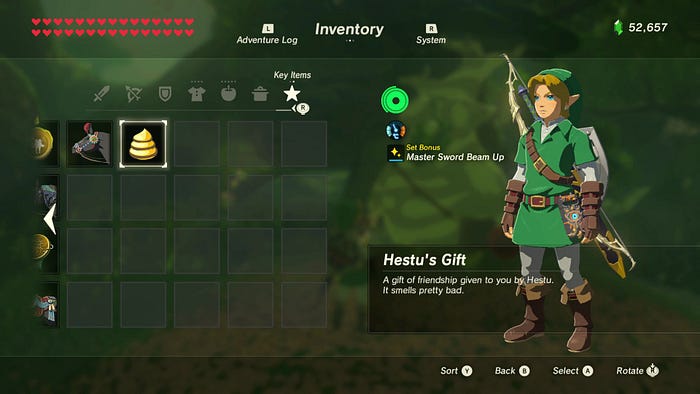Game UX - Existing post-purpose
-a look at Game Lifetime #1-
🇫🇷 Cet article est aussi disponible en Français ici : click click.
When people talk about User Experience, there are some common misbeliefs induced by the use of screens. Interfaces sure are a mean to help or guide the players, but they trully are a thin part of UX overall.
The notion of ‘Game Lifetime’ is a subtle nuance between strictly technical data such as time passed, assumed potential leading to replayability and also blurrier and more personal feelings such as engagement, affect, thirst for completion, cozyness, challenge and so on...

The goal: Finishing as an end
There was a time where finishing the game was enough. It was the only goal. And for some games, today, this use of the time is still really appropriate and well-achieved. It was usual for single-player games to bring a sense of closure to the one achieving them, a final touch to the story as a good one-shot movie could provide. Defeat the great villain, free your best friend or lover, come back home safely, reach the higher ground, etc… All of this and more can be categorized under one same appellation: The Ultimate Goal.
With this scheme, the game and its progression go in one simple way: making the road that separates you from the end a little bit shorter by every step. Older games often used this plan of action, and there are several reasons for this. Technical ones, for example. When the memory on a cartridge (or disc) is limited, one must chose wisely what to do and how to use every single bit of space to form a path and delineate an end.

What now?
So, you beat the final boss. Ok. And what now?
For a long time, the question was not even to ask. The player just finished the game. Congratulations and thanks for liking it. If one wanted to extend the time spent on the game, the only options was to re-live the adventure from the beginning, like a newcomer but armed with the knowledge of your previous life.
But time flies reaaaaally fast and ideas come and go with it. Games genres are multiplying and some of them offer a longer taste of adventure, a different point of view for players to appreciate the evolving environment they are in, and quickly, even games with a ‘final boss’ want to provide an extended experience to their players.
My firsts memories of it were on Nintendo 64. On this part, it is safe to assume that the mechanisms were the same for ‘Mario 64’ and ‘The Legend of Zelda: Ocarina of Time’. When the final boss lays there, vanquished, struck down by the hero, the player assists to the end of the game, final cutscenes, credits scene, fade to black, and then… And then, Home Menu with Save Selection. If I remember it as clearly for Ocarina of Time, it is out of frustration.

‘Did i just won against my worst enemy after several tries only to come back at my last save, JUST BEFORE THE FIGHT?!’
I was young. I didn’t understood. And I paused the game for several months after that, trying to think about something else other than the betrayal this game I loved so much put me through. And one day, I got it. There was more to do. I remembered about the Gold Skulltulas, the house and these poor people trapped in-between ugly and scary transformations. That was it. I should have helped them. I didn’t finished the game. I had more to see.
But the path continued. The time made its way. And now, players can find tons of new ways to come back in their favourite game, with methods working better for some than others.
New Game + -with a higher difficulty level-, Timeattack -beat the game faster than the first time-, New Items -a reload with a new set of items-, Endgame -with new challenges-, Free roam -to explore and enjoy the view- or even just the same, the last save they had before the Boss fight to walk away and find what you missed first…
Exploration
With technological advancement came new prowess. More mechanics, more systems, more enemies, more variety and in our case, more land to explore. Larger worlds are built with every generation, and with them grows the multiplication of spots to hide cool things, such as collectibles or wholesome and stunning environments.
Level-designing for exploration has taken a turn and took flight from purely technical constraints, relying on human behaviour to increase engagement and push the players to discovery.

By stimulating the curiosity of the players, game devs multiply engagement and, as they could discover the surroundings of their home in a new city, the players will have to find distinct landmarks to be able to place themselves in their new habitat. Building strong landmarks is easing the sens of direction, and therefore bringing the players to strenghten emotional ties, as they would in their own neighborhood. This emotional entanglement can even form new functions by itself, as in MMORPGs where simple cities become capitals only because of the affect the players have with it, as if it was part of their own IRL home.
A side of fries
So the environments are getting bigger and bigger, but how to make the players discover it then? Side quests, of course! But not only.
The first tool to start is obviously the main storyline, and it often takes place over various locations by disseminating key events or key items around the whole world. Along the way are placed distractions to accept or run away from.

The decision made by the player when accepting (or not) a side quest is based on a lot of factors. Of course, the nature of the player weighs a big part in the balance (Hi, Completionists, how are you today?) but not only. The mood of the player, the amount of time left for this gaming session, the feeling about the challenge itself, the cozyness of the surroundings, the tiredness, the number of tries, and the list goes on and on… However, side quests can also be a trap. A quick quest to achieve can incite players, and then lead them to another very quick quest, which will lead them to a cool spot to visit, where a new quick quest will be placed, and… anyway, you get it!
But the tipping point between ‘the need to do a side quest for exploration’ and ‘the need to explore to find side quests’ is thin and need to be tweaked with caution, at the risk to lose the part of your playerbase which is not really driven by wild adventure and hours of exploration. At some point, there is a ‘too much side quests‘ (and it’s 900 Korok Seeds 🍃).
And for what?
Far beyond pride and dedication to completion, existing and coming back in a world where you abolished the main threat need to be guided by desires.
In Mario 64, when you reach the 120 stars threshold, a canon will propel you on the rooftop of Peach’s Castle where you will meet Yoshi, that will give you 100 lives. That remains a proper sign that the player have beaten the game. A hundred feels like a pretty high number, and with the mastery they acquired along the storyline, it almost feels like invincibility. The player is now free to explore again all the levels… But it seems like they should all be known by now, because the 120 stars were disseminated all over. In the end, this reward may be here just for pure satisfaction and accomplishment, a medal offered for finishing the game. Of course, Bowser has a new message if you have it all. Feels like the first time I’ve encountered a True Ending.
Side quests can provide rare items, exclusive gears or even crucial narrative content to enhance the overall storyline.
Sometimes, the players will be rewarded by the apparition of new ending scenes, or paths that were only unraveled to the real ones, the ones that finished everything. Some games push this ‘alternative endings’ method very far, and if you are interested, you should definitely try the NieR series.

And sometimes, you crawl your way around all path of Hyrule during hours of your life, just to have a virtual golden poop figure in your inventory. Really, Hestu?!!
